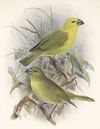Genus Rhodacanthis

Lesser koa-finch - The Lesser Koa Finch has different coloring depending on sex and age. The only specimens caught was a family group with member of different ages and genders, perfect for studying. The males were gold yellow and were olive green on the bottom. The females were almost undistinguishable from its larger relative, other than the fact that it was darker in color. The juveniles are slightly mottled on the belly and are similar to the females. It is small as its name proclaims, only five inches in size.
Greater koa-finch - The bird was about 10 in long when fully grown. It was the largest known honey-creeper, although its typical weight is unknown. The bird is sexually dimorphic; the male was brilliant scarlet-orange on head, neck, and breast, with lighter orange on its bottom, and olive brown with orange touches on back, wings, and tail; however, the female was brownish olive, and somewhat lighter below. It had a thick black bill which allowed it to break open seed pods that were found in the trees. In historical times, its range was largely confined to the Kona District of the island of Hawaiʻi, although it was observed in the Kīlauea area in 1895 . In Kona, it co-occurred with the closely related Lesser Koa Finch , and the Kona Grosbeak. The Lesser and Greater Koa Finches were once thought by scientists to be the minimum and maximum growth of a single species of Koa Finch.


